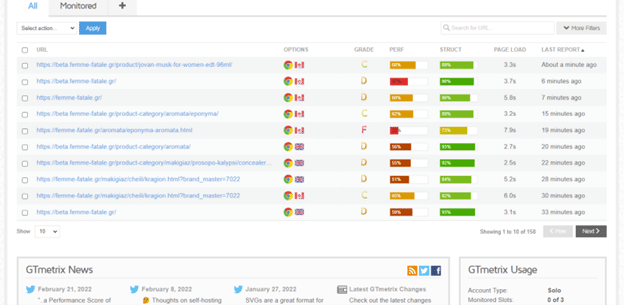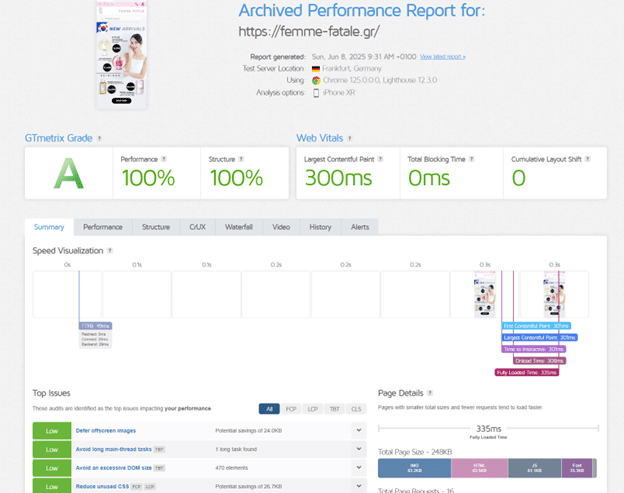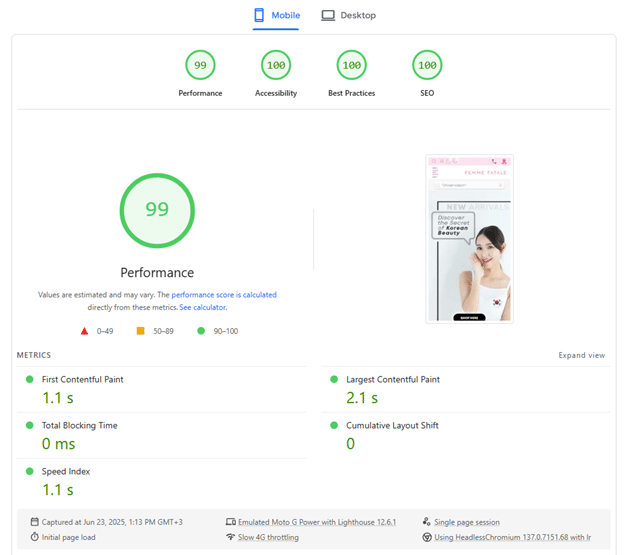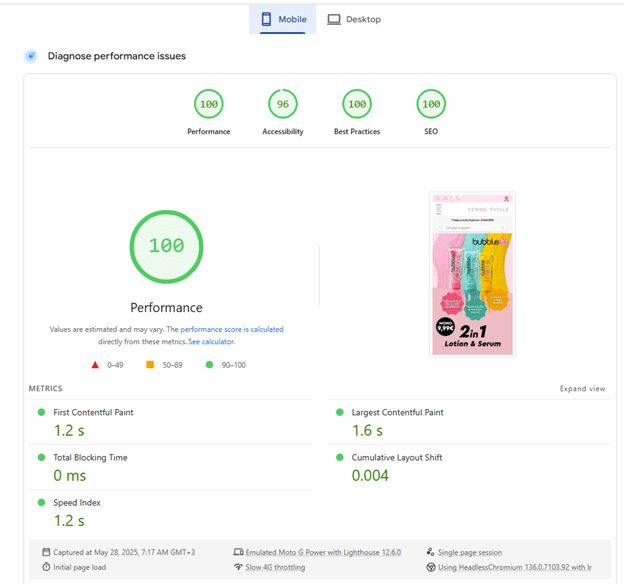Table of Contents
Last update on
Are you aiming to get a perfect 100 on Google’s PageSpeed Insights for mobile with your WooCommerce store?
In this article, I’ll show you exactly how we achieved it with Femme‑Fatale.gr, a beauty e-shop that originally ran on Magento. At that time, mobile page loads took between 5 and 15 seconds, and the site was bleeding sales, despite a 35,000-product catalog with 500 product categories and 450 product attributes.
I’m Dimitris Vayenas, founder of Oxford Metadata. Over the past three decades, I’ve been obsessed over every millisecond of web performance. In early 2022, my friend Nikos Orfanos asked me to help with his online store, and we got to work.
After migrating to WooCommerce and focusing entirely on speed –using WP Rocket as our secret weapon– we smashed mobile PageSpeed scores with a consistent score between 99 and 100/100 score. More importantly, the site went from stagnant to revenue machine.
Keep reading and you’ll learn how we managed to get such results and how WP Rocket helped us reach a 95+ score, plus the final tweak that pushed us to a perfect 100. More importantly, you’ll find out the business impact that followed once the site started loading in just 300 milliseconds.
Why Focus on Performance, Especially on Mobile
At Femme‑Fatale.gr, more than 90% of purchases happen on mobile. That made mobile performance our top priority from day one.
Mobile devices are the ultimate stress test for any website. Limited CPU, memory, and unstable connections can make even the leanest pages load up to 10 times slower than on desktop. That’s why every optimization matters.
Speed means efficiency. Cleaner code, smaller assets, and a leaner DOM translate into a smoother experience for every visitor, especially on mobile.
As I like to say: “If your mobile experience isn’t instantaneous, you’re losing real money with every extra millisecond”.
The Turning Point: Migrating from Magento to WooCommerce
In December 2021, Nikos reached out with a clear challenge. “My store peaked during lockdown at €0.81 per session. Then sales fell back to €0.15 per session. Can we get back to lockdown highs?”
We knew the first step was changing platforms.
First off, we chose WooCommerce for its agile, modern stack. It offered an ecosystem of plugins and theme creators that cover every functionality imaginable, along with the largest community of performance-minded web engineers.
We went live in March 2022 without changing product data or increasing marketing spend. The only difference was speed. We cut page loads from 5 to 10 seconds down to just 1 to 2 seconds.
This is the GTmetrix screenshot showing the loading time results before the migration from Magento: 5.8 seconds for the homepage and 7.9 seconds for the category, captured while we were still developing the new website.

On the other hand, this is the current performance, with all core Web Vitals in green:

What’s the True Value of Speed for Your eCommerce Store?
The business impact on performance was impossible to ignore, and the numbers made it crystal clear.
Before the migration, Femme‑Fatale.gr had been stuck in a performance rut. On Magento, monthly turnover ranged from €7,000 to €10,000 with about 40,000 sessions, averaging just €0.15 to €0.20 per session. Even during the lockdown peak in 2020, when traffic surged to 62,500 sessions, the best performance topped out at €0.81 per session.
By February 2022, just before we migrated to WooCommerce, the site had improved slightly to €0.29 per session, but it was still far from its potential.
The impact of faster performance was immediate. In March 2022, the first full month after the migration, revenue per session doubled to €0.58, despite a temporary dip in sessions while bots warmed up caches.
The gains didn’t stop there. By December 2023, we matched the lockdown peak of €0.81 per session. Today, that number has climbed even higher: the website now earns €1.11 per session with 40,000 monthly visits.

Nikos, the owner of Femme‑Fatale.gr, put it best:
By matching and now exceeding our COVID peak, we proved speed is the single biggest lever on our business.
The Performance Foundation Every WooCommerce Site Needs
Before WP Rocket could deliver its full performance potential, a solid foundation needs to be in place. These early decisions had a major impact on our results, and this is also what I highly recommend to anyone running a WooCommerce store:
- Choose a performance‑first theme: We tested dozens of themes before settling on the best options. Botiga (Gutenberg-based) by aThemes and Rey Theme (Elementor-based) both scored 90+ in vendor demos. Anything below 70? We avoided it.
- Pick a truly fast host: We use Cloudways, backed by Linode, Vultr, and DigitalOcean across key European regions like London, Frankfurt, Amsterdam, Milan, and Stockholm. It gives us one-click PHP and database upgrades, built-in Varnish and Redis, plus seamless mobile device detection. That ensures uncached API calls always hit optimized content. We’ve had zero downtime in three years, and their support team is outstanding.
In e‑commerce, proximity to your customers is non‑negotiable: every product query, cart update, and inventory check touches your origin. With shoppers in Athens or the Greek Isles, and Cloudways not having a local node, we have to deploy Fastpath. It peers directly with all major Greek mobile operators and Cloudflare, delivering sub‑50 ms TTFBs and a truly local experience.
- Partner with supportive vendors: We chose vendors that offer reliable and quick support to answer questions and troubleshoot by your side, from aThemes and FiboSearch to WeLaunch, Pixel Your Site, Gravity Forms, AIOSEO, and WP Rocket. The same goes for Pods Framework, WP Datatables, and Namaste LMS.
- Optimize your content: We converted all images to WebP and organized them into date-based folders, ensuring each folder contains fewer than 10,000 files. For fonts, we self-hosted WOFF2 files and subset them to include only the characters our audience needed. That reduced font file sizes by 70 to 80 percent. Serving them locally and preloading early helped eliminate external lookups and avoided layout shifts.
- Use surgical plugin loading and maintain database hygiene: We used Plugin Organizer and manual filters to load only the plugins needed per page. We also cleaned transients weekly and disabled autoload for large wp_options entries.
The WP Rocket Features That Took Us to 99/100 on PageSpeed
Once the foundation was in place, WP Rocket helped us boost speed and achieve outstanding performance results quickly. These features played a key role in getting us to a 95+ score on Google PageSpeed on mobile:
- Mobile Cache and Sitemap Preload: WP Rocket automatically detects mobile devices and builds a dedicated cache for them. That means smartphone users always get a preloaded HTML snapshot. The sitemap-based preloader also crawls your pages right after any cache purge, which removes the delay that often happens on first visits.
- CSS and JS Minification: WP Rocket strips out whitespace and comments to shrink file sizes. It can also combine JavaScript files into one, reducing the number of HTTP requests. That’s especially important for mobile users on slower networks.
- Remove Unused CSS (RUCSS): Unlike simple minification, RUCSS analyzes your pages’ HTML and strips out every CSS rule never used on the front end. This declutters stylesheets often cuts tens of kilobyte, so the browser renders faster with fewer bytes. We saw firsthand that Enabling RUCSS alone shaved 200 KB off our homepage payload, resulting in faster loading pages.
- Delay JavaScript Execution: Scripts like analytics, chat tools, or third-party widgets usually don’t need to run right away. WP Rocket delays them until the user scrolls, taps, or clicks. This makes pages interactive faster and improves Interaction to Next Paint and page’s overall responsiveness to user interactions.
After enabling these features, we got a 99 mobile PageSpeed performance score:

Bonus: WP Rocket Add‑Ons for Special Cases
Sometimes out‑of‑the‑box settings need a little boost. For select setups like ours –with complex schedulers, custom font rules, or unusual device detection– we installed five free WP Rocket add‑ons after consulting WP Rocket senior engineers:
- Change RUCSS Parameters: We adjusted how often and how deeply WP Rocket runs Remove Unused CSS. This was essential for compatibility with plugins like AutomateWoo, which may overload the task scheduler.
- Deactivate WooCommerce Cart Fragments: Since our database was already optimized, we disabled WP Rocket’s cart-fragment cache to speed up checkout calls even further.
- Disable Used CSS Fonts Preload: We used custom self-hosted WOFF2 fonts with manual preload rules. This add-on ensured those rules weren’t overridden by WP Rocket’s automatic font preload.
- Remove HTML Expires Rules: Our CDN and server already handled cache headers, so we removed WP Rocket’s default HTML expires rules to avoid conflicts.
- Set Tablets as Mobile: We treated tablets like mobile devices to ensure they benefited from mobile caching and responsive optimizations. This was important for custom functionality relying on the wp_is_mobile() check.
Aside from the tablet plugin, most of these add-ons are only needed in high-complexity stores. For typical eCommerce setups, WP Rocket works great right out of the box.
The 100/100 Secret: Perfecting LazyLoading and That LCP Image
Reaching 99 on Google’s PageSpeed Insights was a big milestone, but we weren’t satisfied. One point stood between us and perfection.
First, we tackled element bloat, which means reducing the number of HTML elements on the page. Google penalizes pages with more than 810 DOM elements, and our menus, sliders, and footer alone pushed us well past 1,000.
Here’s what we did:
- Lazy-loaded static content : We deferred non-critical elements like header menus, product category sliders, brand carousels, and the footer until after the initial paint.
- Removed unnecessary elements: We pruned deep menu levels and disabled inactive widget areas on mobile. That helped us get the total DOM count below Google’s penalty threshold.
Even with a cleaner page, we still couldn’t crack 100. The final issue was the hero image.
Originally, it was a 350×622 px image with overlays, shadows, and text – too complex to load fast. We simplified it down to a 350×350 px WebP and preloaded it with high priority using the following code:
add_action('wp_head','ff_preload_mobile_image',1);
function ff_preload_mobile_image(){
if(!is_front_page()||!wp_is_mobile()) return;
echo '<link rel="preload" as="image" href="/uploads/lcp-simple.webp" importance="high">';
}And that’s how, by simplifying and preloading the hero image, we achieved a perfect 100/100 PSI score from mobile.

The Business Impact: Speed as a Growth Engine
As I explained, speed didn’t just improve our PageSpeed score. It directly boosted our bottom line.
After optimizing performance and leveraging WP Rocket features, we saw measurable gains in results:
- Conversion rates jumped by 33%.
- Revenue per session increased more than five times, from €0.20 to €1.11.
Those results translated into an additional €384,000 in revenue during the first 18 months after the migration.
These weren’t minor improvements. They matched and eventually surpassed our peak lockdown performance, proving that site speed was the key lever for growth.
As I like to say: “Every millisecond shaved added real euros to the bottom line.”
3 Practical Tips for Business Owners
If you’re running an eCommerce store, I’d like to share some additional practical tips can help you get the most out of your performance efforts – whether you’re technical or not.
- Track Real Users: Use Real User Monitoring (RUM) to keep an eye on field data. Lab scores are useful, but what really counts is how your site performs for actual visitors. Just make sure to disable it when running PageSpeed Insights tests to avoid skewed results.
- Geolocate Your Origin: Host your site close to your customers. When your origin server is near your audience, everything from product searches to checkout becomes faster and more reliable.
- Lean on WP Rocket: Start with the default settings. They automatically handle most performance issues right away. Once your baseline is solid, you can fine-tune by enabling some additional features, for instance to optimize CSS and JS files. And if you’re not tech-savvy, remember: “Faster sites mean less frustration, more sales, and happier customers.”
Wrapping up
We moved from Magento to WooCommerce, raised our mobile PageSpeed score from 55 to a perfect 100, and increased revenue per session from €0.20 to €1.11. That journey proved one thing clearly: speed is more than a technical milestone. It is a real driver of business growth.
We focused on performance, built a strong technical foundation, and used WP Rocket to unlock results quickly. If your WooCommerce store feels slow or underperforming, now is the time to take action. A faster site means a smoother experience for your visitors and real gains for your business.



